Explore The Rani Pokhari In Kathmandu For A Serene Experience In 2025

Rani Pokhari, meaning “Queen’s Pond”, is a historic artificial pond in the heart of Kathmandu, Nepal.
Constructed in 1670 AD by King Pratap Malla, it was built to console his grieving queen after the tragic death of their son. The pond is famous for its religious importance, scenic beauty, and the Mahadev temple that was built in the centre. Some parts of the site were destroyed during the earthquake of 2015, but now there is active work to restore its grandeur. The pond is lively much of the time and is where many in the local community celebrate their age-old festivities such as the Dashain and Tihar.
History And Significance Of Rani Pokhari Nepal
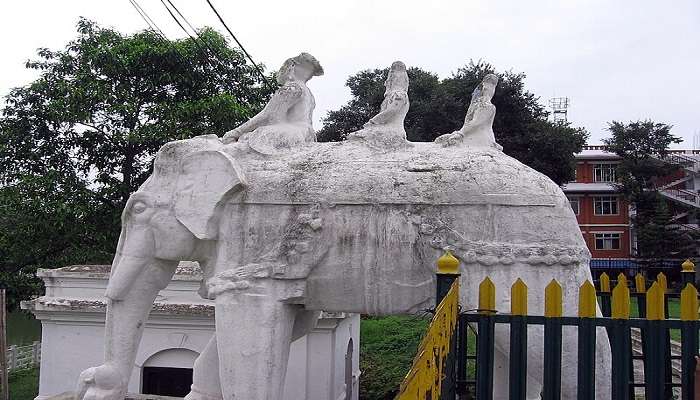
Rani Pokhari History reveals that King Pratap Malla of Kathmandu ordered the creation of Rani Pokhari, or “Queen’s Pond,” in the 1600s. This pond was constructed by the king following their son’s death and the queen’s subsequent grief. The main attraction of the pond was a structure in the middle of it, a pagoda (temple) to Lord Shiva.
The pagoda known as Rani Pokhari Mandir or Nil Saraswati Mandir bows out on the justification for magnificence in Newari architectural design with fine woodcarving. During festivals like Dashain and Tihar, it becomes overcrowded, and the pond becomes a festive ground for celebration. It is a place of cultural significance that is worth visiting in Kathmandu.
Also Read: Tourist Places In Nepal
Timings And Entrance Fee And Best Time To Visit
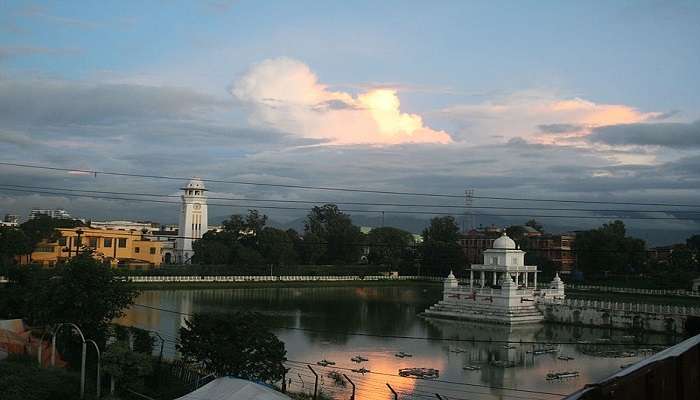
Rani Pokhari timings are usually daily from 6:00 AM to 6:00 PM. It’s best to visit early or later in the afternoon to avoid the midday heat and experience a quieter, more reflective atmosphere. Rani Pokhari entry is free for Nepalese citizens, while SAARC nationals usually pay around NPR 50. International visitors are typically charged about NPR 100. While Rani Pokhari doesn’t enforce a strict dress code, you should dress to show respect for the site’s cultural and religious importance.
Plan your trip to Rani Pokhari between October and March to enjoy the cool weather in Kathmandu. Mornings and late afternoons offer calm and beautiful views. A visit to Tihar, which happens in October or November, allows you to experience the culture. During this festival, lights and decorations make the pond and its surroundings look stunning.
Experiences You Will Get At Rani Pokhari Nepal
Rani Pokhari is a place of interest for historians, culture lovers, nature enthusiasts or anyone who wants to have time to ponder over happenings. Here are some experiences you can look forward to:
1. Beautiful Architecture
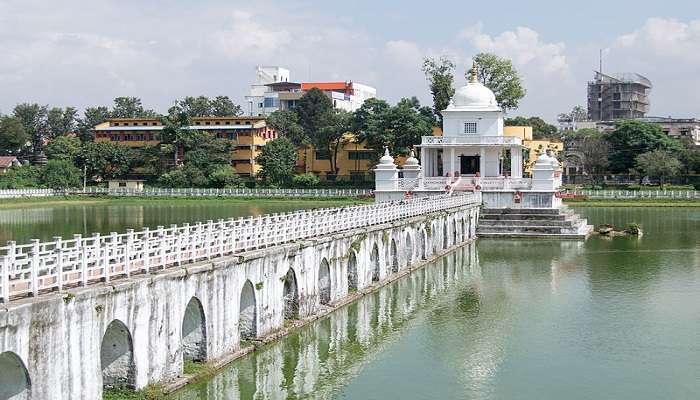
Like any other temple area of Nepal, Rani Pokhari possesses a grand architectural structure considered significant in Nepali style. The ceiling of this gallery is made of stones, erected in the mid-17th century.
In the centre of this pond is the Balgopal Eshwar Temple, a marvel of art with exquisite carving. The structure of the temple combined with the area is fully adorned with art, making it depict excellence in craftsmanship as well as the period of construction. Each temple element is imbued with intricate construction concepts and a commitment to aesthetic flair.
Related Post: Best Places To Visit Near Kathmandu
2. Cultural Insight
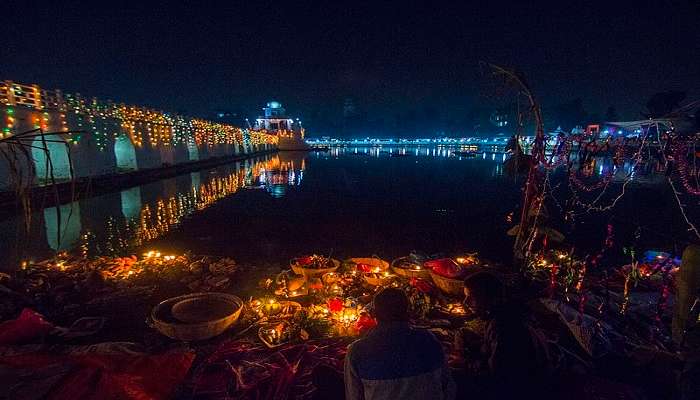
Visiting Rani Pokhari puts one right in the heart of Kathmandu’s vibrant cultural and spiritual activity. During festivals such as Tihar, the pond becomes a cultural hub or ground of festivity and togetherness.
Such festivals make Rani Pokhari into an ancient ritual and merrymaking zone, and it is your rare chance to watch culture through the eyes of Nepalis. This will also help you to have more exposure to the cultural extravaganza of Kathmandu during your vacation.
3. Scenic Tranquillity
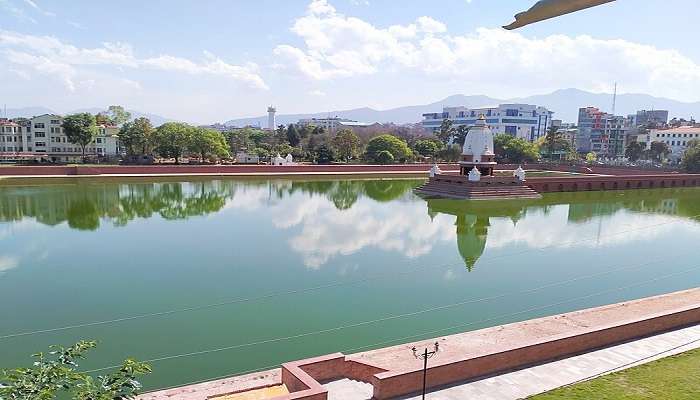
Rani Pokhari is serene and a getaway from the noise and the haste of city life. The quiet around the pond makes one walk or sit by its waters, immersing oneself in surroundings that are so peaceful and lovely.
Treetops and historical buildings surround it, providing an atmosphere that forces people to sit and think. It provides an excellent place for people to rest, rejuvenate, and spend their time amidst nature in the middle of the city.
Related Post: Lakes In Nepal
4. Photography
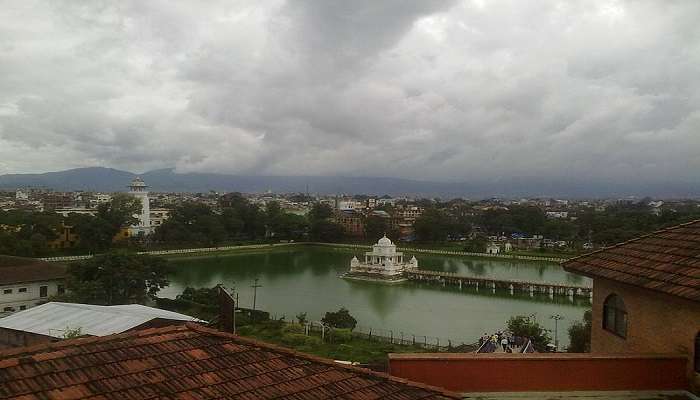
Rani Pokhari is rich in picture-postcard views and historic architecture that will allow tourists to take fascinating pictures. There are some very diverse and exciting things to capture in the pictures, from the reflection on the water to the temple and the territories around it.
The tile mosaics in the temple, the reflection of the temple in the water body adjoining the structure, or the bustle during a festival; all sum up to provide Rani Pokhari with great prospects of acquiring beautiful picture-perfect frames.
Rani Pokhari Nepal Places To Visit Nearby
Rani Pokhari Nepal is a place to visit. It has a legendary love story attached to its past as the pond where King Pratap Malla and his queen used to come and enjoy themselves.
1. Swayambhunath Stupa
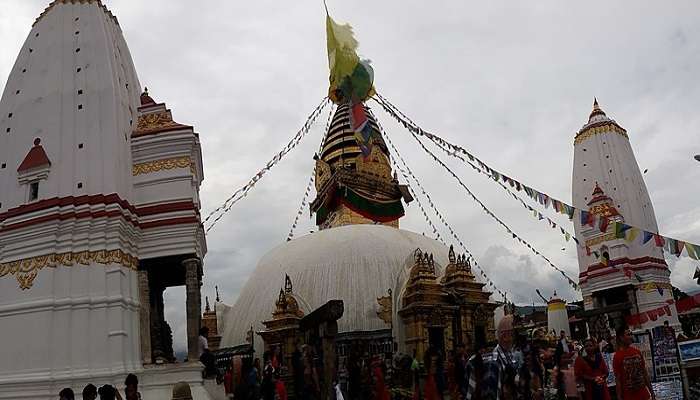
This UNESCO World Heritage Site is called the Monkey Temple by the locals. It is one of the region’s most revered religious destinations. Perched atop a hill, this temple offers a 360-degree view of the sprawling Kathmandu Valley. But, to reach the summit, you will have to climb 365 steps. The site has a beautiful white dome at the bottom, which is said to represent the entire universe. Likewise, the tall 13-storey tower represents the thirteen stages of nirvana. Additionally, the nose-like design on the temple represents unity, making the stupa a peaceful place for everyone who visits.
- Timings: Open 24 hours
- Entry Fee: NPR 50 for Indians and SAARC nationals and NPR 200 for Chinese citizens and foreign nationals
Related Post: Museums In Nepal
2. Thamel
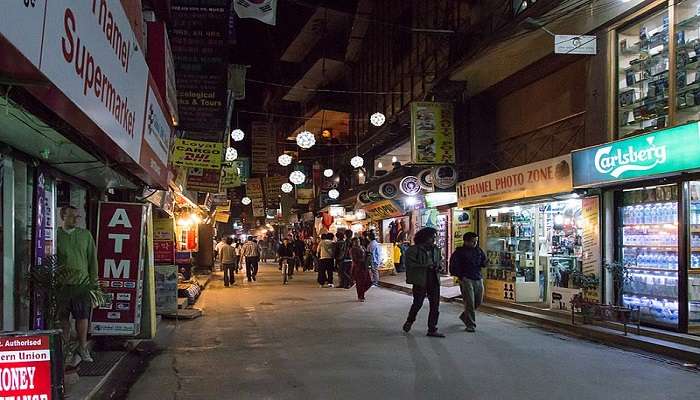
Thamel is one of the most famous districts in Kathmandu, Nepal; a dense concentration of stores and recreational facilities distinguishes it. This is one of the most touristic areas in the city, with lots of opportunities to find shops, cafes, restaurants and even hotels. Thamel is known for its entertainment, especially the many nightclubs and bars which are open to all. Its small, meandering streets lined with craft, clothing and souvenir shops are a joy to explore. The district also has a blend of traditional and contemporary styles, offering visitors a combination of the Nepalese culture and friendly environment.
- Timings: 9 AM to 9 PM
- Entry Fee: None
3. Garden Of Dreams
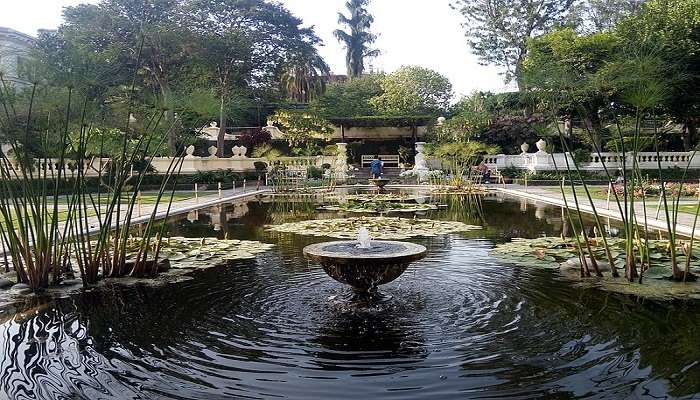
This beautiful place, created by Kishore Narshingh, is perfect for a peaceful picnic where you can unwind and find inner peace. It not only has lovely gardens but also an outdoor theatre, ponds, fountains, and grassy areas—Kishore Narshingh designed and built this peaceful sanctuary in 1920. Whether you’re looking for a serene place for ultimate rejuvenation or wish to explore the local flair of the region, Garden of Dreams is worth a visit.
- Timings: 9 AM to 10 PM
- Entry Fee: NPR 150 for local people and NPR 400 for others
Related Post: Heritage Places In Nepal
4. Pashupatinath Temple
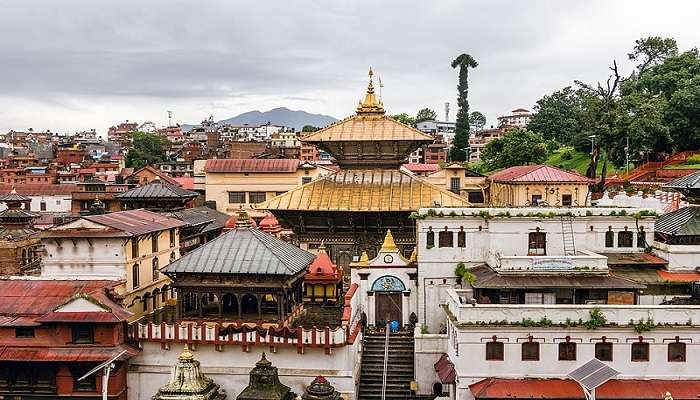
This Hindu shrine sits by the holy Bagmati River and ranks among Nepal’s most important religious sites. The extensive temple grounds showcase pagoda-style buildings with detailed wood carvings. People also use this place for cremations, blending Hindu customs with local traditions. The temple’s deep spiritual meaning and stunning design draw in faithful visitors and sightseers. It gives them an honest look at Nepal’s religious ways and rich culture.
- Timings: 10 AM to 5 PM
- Entry Fee: Free for locals and Indian citizens, and NPR 1000 for foreign nationals
How To Reach Rani Pokhari
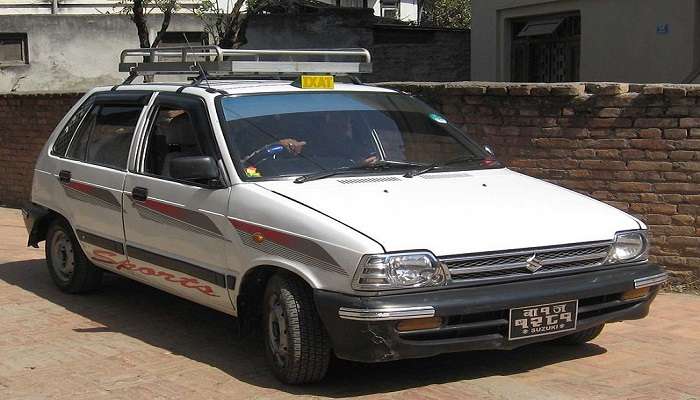
Rani Pokhari lies in the centre of Kathmandu, so reaching it is hassle-free. You have several options: You can find an ample number of taxis from the main region of Kathmandu. They offer a quick and easy way to reach Rani Pokhari.
Local buses and microbuses that will drop you to Rani Pokhari can also be found. You can check with locals to find the best route from your stay. If you’re staying in the Thamel area or nearby, you might enjoy a pleasant stroll to Rani Pokhari. This lets you enjoy the sites and essence of Kathmandu as you travel.
You May Also Like To Read: Places To Visit In Nepal For Honeymoon
Rani Pokhari is among the most captivating historical landmarks that can be found in Kathmandu, which preserves the spirit of the Nepalese kingdom. The landscapes of a small rough town, surrounded by the centuries-old buildings and calm water reflect the cultural and historical depth of the location. Plan a trip to Kathmandu and visit Rani Pokhari, to witness the city’s rich history and architectural heritage embraced by Mother nature’s beauty.
For our editorial codes of conduct and copyright disclaimer, please click here.
Cover Image Credit :Bijay chaurasia for Wikimedia Commons
Frequently Asked Questions About Rani Pokhari
Where is Rani Pokhari?
Rani Pokhari is in the centre of Kathmandu, Nepal, close to Durbar Square. Its central location makes it easy to visit and highlights its importance in the city.
What are the main attractions and features of Rani Pokhari?
Rani Pokhari boasts a peaceful man-made pond with the Balgopal Eshwar Temple at its heart, which you can reach by crossing a stone bridge. It’s known for its rich history and calm surroundings.
What is the best time of the year to visit Rani Pokhari?
Spring and autumn are the best seasons to visit offering mild weather and clear skies. A trip during the Tihar festival gives you a chance to experience unique local customs.
What are the opening hours of Rani Pokhari?
You can visit Rani Pokhari from early morning to late evening. The Balgopal Eshwar Temple in the middle opens to the public during specific festivals like Tihar.
Is swimming or boating allowed in the waters of Rani Pokhari?
The authorities don't allow swimming or boating in Rani Pokhari. It's a holy place meant for religious and cultural events.
People Also Read:
Places To Visit In Kathmandu Museums In Kathmandu Shopping In Kathmandu

With a passion for exploring and travelling to the roads long forgotten, experience the world through enthralling stories and adventures. Join me as I share my experiences at some of the world’s most popular tourist destinations and quench that pestering curiosity with something exciting!











